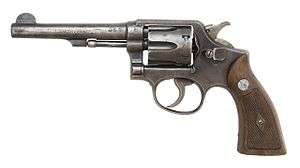Smith & Wesson Model 1
| Smith & Wesson Model 1 | |
|---|---|
|
A Smith & Wesson Model 1, 2nd Issue. This is a two patent date variety shown next to a period box of .22 short black powder cartridges. | |
| Type | Revolver |
| Place of origin | United States |
| Production history | |
| Manufacturer | Smith & Wesson |
| Produced | 1857-1882 |
| Number built | approx. 12,000 (1st Issue), 110,000 (2nd Issue), 131,000 (3rd Issue) |
| Specifications | |
| Caliber | .22 Short Blackpowder |
| Action | Single Action |
| Feed system | 7-round cylinder |
| Sights | Fixed |
The Smith & Wesson Model 1 was the first firearm manufactured by Smith & Wesson, with production spanning the years 1857 through 1882. It was the first commercially successful revolver to use rimfire cartridges instead of loose powder, musket ball, and percussion caps. It is a single-action, tip-up revolver holding seven .22 Short black powder cartridges.[1]
History
Early history
As Samuel Colt's patent on the revolver was set to expire in 1856, Horace Smith and Daniel B. Wesson were researching a prototype for a metallic cartridge revolver. When they discovered that a former Colt employee named Rollin White held the patent for a "Bored-through" cylinder, a component needed for this new invention, the two partners approached White to manufacture a newly designed revolver-and-cartridge combination.[2]
Rather than make White a partner in their company, Smith and Wesson paid him a royalty of $0.25 on every "Model 1" revolver that they made. It would become White's responsibility to defend his patent in any court cases which eventually led to his financial ruin, but was very advantageous for the new Smith & Wesson Company.[2]
Variants
The Model 1 had three issues or major variants, with each subsequent issue introducing significant technical changes.
1st Issue
The 1st Issue of the Model 1 was the first major iteration (and the least common), with approximately 12,000 produced over a three year period. The features that easily distinguish the 1st issue are the flared, square cornered shaped grip (also seen in the 2nd Issue), the small round side plate, the round profile of the frame between the back of the cylinder and the grip, a split articulated hammer, and the flat spring barrel latch seen in some early variants.[2]
There are six known variations of the Model 1, first identified in an article by John Kountz in the April 1956 issue of "The Gun Report". In this article, Kountz noted specific differences in the recoil shield, the barrel latch (the first two variations used a dart style flat spring catch, while later variations used a larger bayonet release), the rifling and other subtle differences.[3]
Serial numbers were issued sequentially for the Model 1 1st Issues ranging from 1 through approximately 12,000.[3]
2nd Issue
The 2nd Issue of the Model 1 looked similar to the 1st Issue, with several notable differences. The side plate on the 2nd Issue was much larger and irregularly shaped. The profile of the frame was flatter (a likely concession for manufacturing efficiency), and the hammer was now made in one piece. Model 1 2nd Issues still had the flared, square cornered shaped grip and the octagonal tip-up style frame, and at first glance the two issues are easy to confuse.[3]
There were approximately 110,000 2nd Issues produced from 1860 through 1868, with serial numbers ranging from approximately 12,000 (following the 1st Issue) through to approximately 120,000.[3]
3rd Issue
The Model 1 3rd Issue represented a substantial redesign for the Model 1, with a fluted cylinder, a round barrel and a rounded "bird's head" style grip. Finishes included full nickel plating, full blued steel, and a "half plate" nickel/blue combo. Produced from 1868 through 1882, the 3rd Issues were serial numbered from 1 through approximately 131,000.[3]


Popularity
The Model 1 was in popular demand with the outbreak of the American Civil War as soldiers from all ranks on both sides of the conflict made private purchases of the revolvers for self-defense. So much that orders for the Model 1 revolver outpaced the factory's production capabilities, forcing Smith & Wesson to expand into a new facility and began experimenting with a new cartridge design more suitable than the .22 Short in 1860.[4]
This popularity led to numerous knockoffs and patent infringements by other armsmakers. Rolin White and S&W brought infringement cases against Manhattan Firearms Company, Ethan Allen, Merwin & Bray, National Arms Company and others. The courts mostly allowed these manufacturers to continue production runs, with a royalty on each revolver paid to White. In some cases, Smith & Wesson bought the revolvers back to remark and sell; these are marked "APRIL 3 1855" as a patent date.[5]
References
- ↑ Chicoine, David (2005). Antique Firearms Assembly/Disassembly: The Comprehensive Guide to Pistols, Rifles & Shotguns. Iola, Wisconsin: Krause Publications. pp. 171–172. ISBN 0-87349-767-8.
- 1 2 3 Boorman, Dean K. (2002). The History of Smith & Wesson Firearms. Globe Pequot Press. pp. 18–22. ISBN 978-1-58574-721-4.
- 1 2 3 4 5 Supica, Jim; Nahas, Richard (2007). Standard Catalog of Smith & Wesson. Iola, Wisconsin: F+W Media, Inc. pp. 30–37. ISBN 0-89689-293-X.
- ↑ Kinard, Jeff (2004). Pistols: An Illustrated History of Their Impact. ABC-CLIO. pp. 114–117. ISBN 978-1-85109-470-7.
- ↑ Walter, John (2007). Rifles of the World (3 ed.). Krause Publications. pp. 108–109. ISBN 978-0-89689-241-5.

